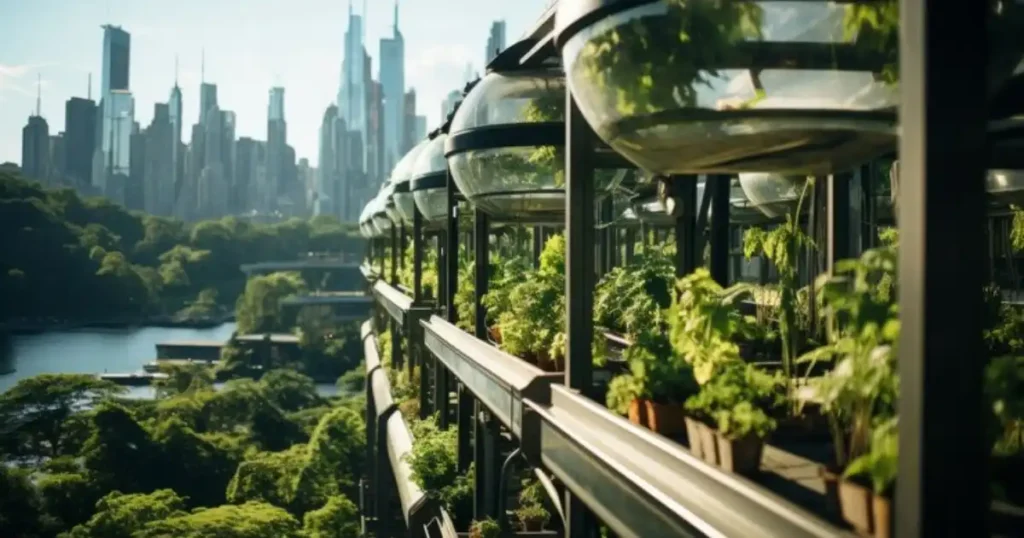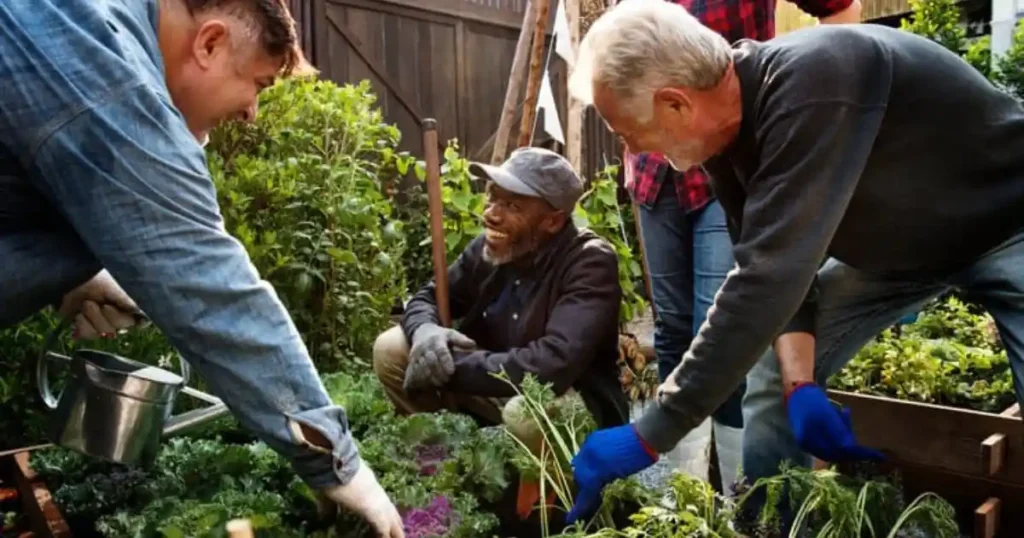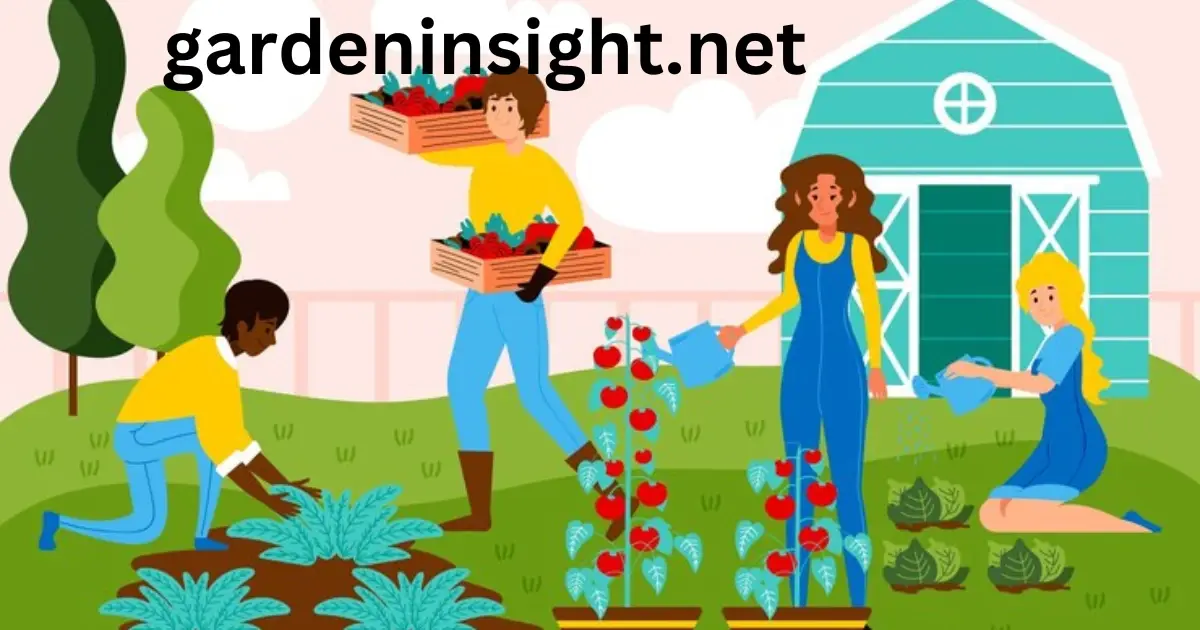Urban agriculture and community gardening are often used interchangeably, but they are distinct approaches to growing food in urban environments. While urban agriculture and community gardening both contribute to local food systems and green spaces, they differ in scale, purpose, organization, and impact.
This article will explore the key differences between urban agriculture and community gardening, examining unique characteristics and contributions of urban agriculture and community gardening to sustainable cities.
What is Urban Agriculture?

Urban agriculture encompasses various methods of food production within cities or their surrounding areas. It includes diverse activities like rooftop farming, vertical farming, hydroponics, aquaponics, and even raising small livestock. Urban agriculture often involves a higher level of technology and infrastructure compared to community gardens.
What is Community Gardening?
Community gardening involves residents sharing a common plot of land to grow fruits, vegetables, and flowers. These gardens foster a sense of community and provide access to fresh, healthy produce, especially in areas with limited access to green spaces.
Key Differences Between Two
| Feature | Urban Agriculture | Community Gardening |
|---|---|---|
| Scale | Larger scale, may involve commercial production | Smaller scale, primarily for personal or community use |
| Purpose | Can be for-profit, focused on yield and efficiency | Primarily non-profit, focused on community building and food access |
| Land Ownership | Can be privately owned, leased, or public land | Often public land or land owned by community organizations |
| Technology | May utilize advanced technology like hydroponics, vertical farming | Typically uses traditional gardening methods |
| Community Involvement | Can involve paid employees and volunteers | Primarily relies on volunteers and community members |
| Structure | Can be more structured and business-oriented | Often less structured, with shared decision-making |
What are the Main Goals of Urban Agriculture?
Urban agriculture initiatives aim to:
- Increase food access: Provide fresh, healthy food to urban residents, particularly in food deserts.
- Improve food security: Enhance the resilience of local food systems and reduce reliance on long-distance food transportation.
- Create economic opportunities: Generate jobs and income through food production and sales.
- Promote sustainability: Reduce environmental impact by decreasing transportation needs, utilizing waste resources, and promoting biodiversity.
- Enhance community development: Strengthen community bonds, beautify neighborhoods, and provide educational opportunities.
What Scale is Urban Agriculture Typically Practiced On?

Urban agriculture can range from small-scale rooftop gardens to larger commercial operations. The scale depends on factors like available land, resources, and the goals of the project. Some urban farms utilize innovative techniques like vertical farming to maximize production in limited spaces.
Commonly Used Technologies
In urban agriculture and community gardening, community gardens often rely on traditional gardening methods, urban agriculture may employ advanced technologies like:
- Hydroponics: Growing plants in nutrient-rich water solutions without soil.
- Aquaponics: Combining hydroponics with fish farming, where fish waste provides nutrients for the plants.
- Vertical farming: Growing crops in vertically stacked layers to maximize space.
- Precision agriculture: Utilizing sensors and data analysis to optimize growing conditions and resource use.
Community gardens may also adopt some technologies, like rainwater harvesting systems or composting methods, to enhance sustainability.
What are the Differences in Structure Between Two
Urban agriculture projects can be structured as for-profit businesses, non-profit organizations, or government initiatives. They may have a more hierarchical structure with designated managers and employees. Community gardens, on the other hand, are often managed by the gardeners themselves, with decisions made collectively.
How does Community Involvement Vary Between Two

Community involvement is central to both urban agriculture and community gardening practices, but the nature of involvement differs. Community gardens rely heavily on volunteer efforts and shared responsibilities among gardeners. Urban agriculture projects may also involve volunteers, but they might have paid staff who manage daily operations.
How does Urban Agriculture Impact Food Security?
Urban agriculture plays a crucial role in enhancing food security by:
- Increasing local food production: Reduces reliance on external food sources and strengthens local food systems.
- Improving food access: Provides fresh produce in areas with limited access to grocery stores or affordable healthy food.
- Creating more resilient food systems: Diversifies food sources and reduces vulnerability to disruptions in the global food supply chain.
What Kind of Crops are Commonly Grown in Community Gardens?
Community gardens typically grow a variety of vegetables, fruits, herbs, and flowers. Common crops include tomatoes, peppers, lettuce, beans, squash, and herbs like basil and mint. The choice of crops often depends on the preferences of the gardeners and the suitability of the growing conditions.
Who Typically Manages Urban Agriculture Projects?
Urban agriculture projects can be managed by various entities:
- Private companies: Focus on commercial production and profitability.
- Non-profit organizations: Prioritize community benefits and food access.
- Government agencies: May initiate projects to address food security or promote sustainability.
- Community groups: May manage gardens collectively with shared responsibilities.
What are the Social Benefits of Community Gardening to Urban Agriculture?
While urban agriculture and community gardening both offer social benefits, community gardens often have a stronger emphasis on:
- Social interaction: Provide a shared space for neighbors to connect and build relationships.
- Community building: Foster a sense of belonging and shared purpose.
- Empowerment: Give community members control over their food production and green spaces.
Gain points about urban agriculture and community gardening
| Benefit Category | Urban Agriculture | Community Gardening |
|---|---|---|
| Sustainability | * Reduces food miles: Grows food where people live, cutting down on transportation and pollution. * Uses less water: Can use special ways to water plants, like collecting rainwater or drip irrigation. * Creates less waste: Can use food scraps and yard waste to make compost for plants. | * Helps biodiversity: Provides a home for bees, butterflies, and other helpful creatures. * Improves soil: Uses natural ways to keep soil healthy and prevent it from washing away. * Teaches about nature: Helps people learn about growing food and caring for the environment. |
| Environmental Stability | * Cleans the air: Plants help to clean the air by absorbing harmful gases. * Reduces heat: Green spaces help to cool down cities, which can get very hot. * Protects water: Healthy soil helps to clean and store water, preventing floods and droughts. | * Makes cities greener: Adds green spaces to cities, making them more beautiful and enjoyable. * Reduces pollution: Helps to reduce noise and air pollution from cars and factories. * Connects people to nature: Gives people a chance to enjoy nature and learn about the environment. |
| Social Benefits | * Creates jobs: Provides jobs in growing, processing, and selling food. * Increases food access: Makes it easier for people to buy fresh, healthy food. * Improves health: Encourages people to eat more fruits and vegetables. | * Brings people together: Gives people a chance to meet their neighbors and work together. * Builds strong communities: Creates a sense of belonging and helps people feel connected. * Provides a place to learn: Offers opportunities to learn new skills and share knowledge about gardening. |
How do Community Gardens Benefit Local Neighborhoods?
Community gardens offer numerous benefits:
- Increased access to fresh produce: Provides a source of nutritious food, especially in areas with limited access to grocery stores.
- Improved community health: Encourages physical activity, healthy eating habits, and reduces stress.
- Enhanced social connections: Creates opportunities for neighbors to interact, share knowledge, and build relationships.
- Greener neighborhoods: Beautifies the community and provides green spaces for relaxation and recreation.
- Educational opportunities: Offers hands-on learning experiences about gardening, nutrition, and environmental stewardship.
Environmental Impacts of Urban Agriculture Compared to Community Gardening
Both urban agriculture and community gardening offer environmental benefits, but the impacts of urban agriculture and community gardening differ
Urban Agriculture:
- Reduced transportation: Decreases the distance food travels, reducing carbon emissions.
- Improved air quality: Plants help filter air pollutants and reduce the urban heat island effect.
- Waste reduction: Can utilize organic waste for compost and reduce reliance on synthetic fertilizers.
- Potential for resource-intensive practices: Some techniques like hydroponics or vertical farming may require significant energy and water inputs.
Community Gardening:
- Increased biodiversity: Provides habitat for pollinators and other beneficial insects.
- Improved soil health: Organic gardening practices enhance soil fertility and reduce erosion.
- Reduced water use: Efficient irrigation methods and water conservation practices can minimize water consumption.
How do Urban Agriculture and Community Gardening Contribute to Sustainability?
Both urban agriculture and community gardening practices contribute to urban sustainability by:
- Promoting local food systems: Reduces reliance on long-distance food transportation and supports local economies.
- Reducing environmental impact: Minimizes carbon emissions, conserves resources, and promotes biodiversity.
- Enhancing community resilience: Strengthens local food security and creates more self-sufficient communities.
Is Urban Agriculture More Business-Oriented Than Community Gardening?
Urban agriculture can be more business-oriented, especially when it involves commercial production and sales. However, many urban agriculture initiatives also prioritize social and environmental goals. Community gardening is typically non-profit, focusing on community well-being and food access rather than profit generation.
Conclusion
Urban agriculture and community gardening are both valuable approaches to growing food in cities, each with its own strengths and characteristics. While urban agriculture can be more technologically advanced and commercially driven.
Both urban agriculture and community gardening contribute to more sustainable and resilient urban environments by increasing food access, promoting biodiversity, and reducing reliance on industrial agriculture. Urban agriculture and community gardening can play a crucial role in creating healthier, more vibrant cities.
Both urban agriculture and community gardening offer opportunities for education and skill-building in areas such as horticulture, nutrition, and environmental stewardship. By supporting both urban agriculture and community gardening initiatives, cities can create a more diverse and resilient food system that benefits all residents.
FAQs
What is the Typical Scale of Production in Urban Agriculture Compared to Community Gardening?
Urban agriculture can vary significantly in scale, from small rooftop gardens to larger commercial farms. Community gardens are generally smaller in scale, with individual plots or shared growing spaces.
What are the Primary Purposes of Growing Food in Urban Agriculture and Community Gardening?
Urban agriculture can be driven by commercial interests, aiming to produce food for sale and generate profit. Community gardens are primarily focused on providing fresh produce for personal use, sharing with neighbors, and fostering community connections.
How does Land Ownership Differ Between Urban Agriculture and Community Gardens?
Urban agriculture can take place on private land, leased land, or public land provided by city governments. Community gardens are often located on public land or land owned by community organizations.
Which approach is more Business-Oriented in Urban Agriculture And Community Gardening?
Yes, urban agriculture can be more business-oriented, especially when it involves commercial production and sales. Community gardening is typically non-profit, focusing on community well-being and food access.
How does Community Involvement Vary Between Urban Agriculture and Community Gardening?
Community gardens rely heavily on volunteer efforts and shared responsibilities among gardeners. Urban agriculture projects may also involve volunteers, but they might have paid staff who manage daily operations.
